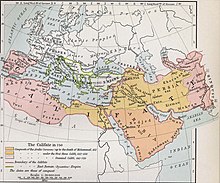
Back الثورة العباسية Arabic আব্বাসীয় বিপ্লব Bengali/Bangla Revolució Abbàssida Catalan شۆڕشی عەباسی CKB Abbásovská revoluce Czech Abasida Revolucio Esperanto Revolución abasí Spanish Abbastar Iraultza Basque جنبش سیاهجامگان Persian Abbasidien vallankumous Finnish
| Abbasid Revolution | |||||||
|---|---|---|---|---|---|---|---|
 The Caliphate in 750 | |||||||
| |||||||
| Belligerents | |||||||
|
Support | |||||||
| Commanders and leaders | |||||||
|
|
| ||||||
The Abbasid Revolution (Arabic: الثورة العباسية, romanized: ath-thawra al-ʿAbbāsiyya), also called the Movement of the Men of the Black Raiment (حركة رجال الثياب السوداء ḥaraka rijāl ath-thiyāb as-sawdāʾ),[2] was the overthrow of the Umayyad Caliphate (661–750 CE), the second of the four major Caliphates in Islamic history, by the third, the Abbasid Caliphate (750–1517 CE). Coming to power three decades after the death of the Islamic prophet Muhammad and immediately after the Rashidun Caliphate, the Umayyads were an Arab empire ruling over a population which was overwhelmingly non-Arab. Non-Arabs were treated as second-class citizens regardless of whether or not they converted to Islam, and this discontent cutting across faiths and ethnicities ultimately led to the Umayyads' overthrow.[3] The Abbasid family claimed descent from al-Abbas, an uncle of Muhammad.
The revolution essentially marked the end of the Arab exclusive Islamic Caliphate and the beginning of a more inclusive, multiethnic state in the Middle East.[4] Remembered as one of the most well-organized revolutions during its period in history, it reoriented the focus of the Muslim world to the east.[5]
- ^ "The Abbasids had been aided in their ascent by the Shia, with whom they had a common cause in revolt." Confounding Powers – Anarchy and International Society from the Assassins to Al Qaeda, Cambridge University Press, 2016, p. 72. [ISBN missing]
- ^ Frye, R. N.; Fisher, William Bayne; Frye, Richard Nelson; Avery, Peter; Boyle, John Andrew; Gershevitch, Ilya; Jackson, Peter (1975). The Cambridge History of Iran. Cambridge University Press. ISBN 9780521200936.
- ^ Paul Rivlin, Arab Economies in the Twenty-First Century, p. 86. Cambridge: Cambridge University Press, 2009. ISBN 9780521895002
- ^ Saïd Amir Arjomand, "Abd Allah Ibn al-Muqaffa and the Abbasid Revolution". Iranian Studies, vol. 27, Nos. 1–4. London: Routledge, 1994.
- ^ Hala Mundhir Fattah, A Brief History of Iraq, p. 77. New York: Infobase Publishing, 2009. ISBN 9780816057672
© MMXXIII Rich X Search. We shall prevail. All rights reserved. Rich X Search